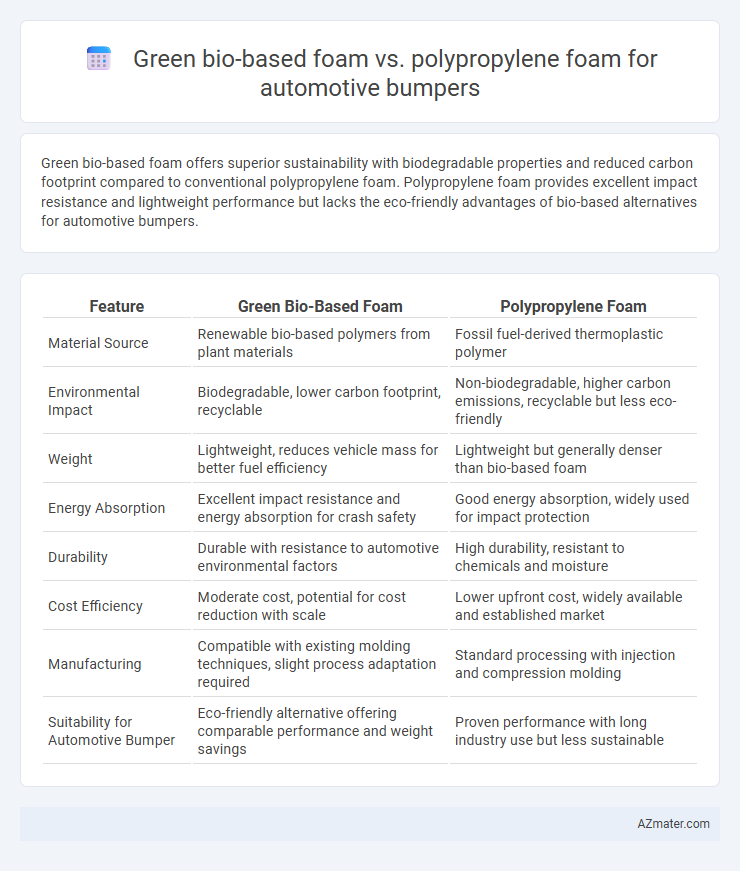Green bio-based foam offers superior sustainability with biodegradable properties and reduced carbon footprint compared to conventional polypropylene foam. Polypropylene foam provides excellent impact resistance and lightweight performance but lacks the eco-friendly advantages of bio-based alternatives for automotive bumpers.
Table of Comparison
| Feature | Green Bio-Based Foam | Polypropylene Foam |
|---|---|---|
| Material Source | Renewable bio-based polymers from plant materials | Fossil fuel-derived thermoplastic polymer |
| Environmental Impact | Biodegradable, lower carbon footprint, recyclable | Non-biodegradable, higher carbon emissions, recyclable but less eco-friendly |
| Weight | Lightweight, reduces vehicle mass for better fuel efficiency | Lightweight but generally denser than bio-based foam |
| Energy Absorption | Excellent impact resistance and energy absorption for crash safety | Good energy absorption, widely used for impact protection |
| Durability | Durable with resistance to automotive environmental factors | High durability, resistant to chemicals and moisture |
| Cost Efficiency | Moderate cost, potential for cost reduction with scale | Lower upfront cost, widely available and established market |
| Manufacturing | Compatible with existing molding techniques, slight process adaptation required | Standard processing with injection and compression molding |
| Suitability for Automotive Bumper | Eco-friendly alternative offering comparable performance and weight savings | Proven performance with long industry use but less sustainable |
Introduction to Automotive Bumper Materials
Green bio-based foam and polypropylene foam are widely used materials in automotive bumper manufacturing, each offering distinct environmental and performance benefits. Green bio-based foam is derived from renewable resources such as plant oils and starches, providing enhanced biodegradability and reduced carbon footprint compared to traditional petrochemical-based polypropylene foam. Polypropylene foam, known for its excellent impact resistance, lightweight properties, and cost-effectiveness, remains a standard choice for bumpers but faces increasing competition from sustainable alternatives focused on circular economy principles.
Overview of Green Bio-Based Foam
Green bio-based foam for automotive bumpers offers enhanced sustainability by utilizing renewable resources such as plant oils, starches, or lignin, reducing carbon footprint significantly compared to conventional polypropylene foam. It provides comparable impact absorption and durability, meeting stringent automotive safety standards while promoting circular economy principles. This foam exhibits improved biodegradability and lower environmental toxicity, driving innovation in lightweight, eco-friendly vehicle components.
Key Properties of Polypropylene Foam
Polypropylene foam boasts impressive impact resistance and lightweight characteristics, making it ideal for automotive bumpers requiring energy absorption and weight reduction. Its excellent thermal stability and chemical resistance ensure durability in extreme temperatures and exposure to automotive fluids. The material's superior recyclability and cost-effectiveness further enhance its appeal for sustainable vehicle manufacturing.
Environmental Impact Comparison
Green bio-based foam for automotive bumpers significantly reduces carbon footprint by utilizing renewable resources and promoting biodegradability, whereas polypropylene foam relies on non-renewable fossil fuels and generates persistent plastic waste. The bio-based foam's lower greenhouse gas emissions during production and end-of-life compostability contribute to improved ecological sustainability compared to the energy-intensive manufacturing and recycling challenges of polypropylene foam. Lifecycle assessments reveal that green bio-based foam offers superior environmental performance by minimizing pollution, resource depletion, and landfill accumulation in automotive applications.
Mechanical Performance Analysis
Green bio-based foam exhibits comparable impact resistance and energy absorption to polypropylene foam in automotive bumper applications, ensuring effective crash protection. The tensile strength and flexural modulus of bio-based foam formulations can be tailored through natural fiber reinforcement, achieving mechanical properties on par with or exceeding traditional polypropylene foams. Thermal stability and durability under cyclic loading also demonstrate that bio-based foams meet automotive industry standards for long-term mechanical performance.
Weight and Energy Absorption Efficiency
Green bio-based foam for automotive bumpers demonstrates lower density compared to polypropylene foam, resulting in significant weight reduction that enhances vehicle fuel efficiency. This bio-based material exhibits superior energy absorption efficiency due to its cellular structure, effectively dissipating impact forces during collisions. Polypropylene foam, while lighter than traditional materials, typically offers lower energy absorption performance relative to advanced bio-based foams optimized for crashworthiness.
Cost Analysis and Market Availability
Green bio-based foam for automotive bumpers offers competitive cost advantages due to renewable raw materials and potential for lower energy consumption during production, yet it may face higher initial processing expenses compared to traditional polypropylene foam. Polypropylene foam remains widely available with established supply chains, benefiting from economies of scale and consistent pricing, making it a cost-effective choice for large-scale automotive manufacturing. Market availability of green bio-based foam is expanding as demand for sustainable materials grows, but polypropylene foam currently dominates the market due to its proven performance and accessibility.
Manufacturing and Processability
Green bio-based foam for automotive bumpers offers sustainable advantages with lower carbon footprint and enhanced biodegradability compared to polypropylene foam. Manufacturing processes of bio-based foam utilize renewable resources and often require lower energy input, promoting eco-friendly production cycles. Polypropylene foam excels in processability with robust thermal stability and established molding techniques, enabling efficient mass production and superior mechanical properties for automotive applications.
Future Trends in Automotive Bumper Materials
Green bio-based foam for automotive bumpers is gaining traction due to its renewable origins, reduced carbon footprint, and enhanced recyclability compared to traditional polypropylene foam. Innovations in bio-based polymers and natural fiber reinforcements are driving improvements in mechanical properties and impact resistance, meeting stringent automotive safety standards. Future trends emphasize integrating sustainable materials without compromising performance, with industry leaders investing in advanced bio-composites to replace conventional polypropylene foams.
Conclusion: Choosing the Right Foam for Sustainability
Green bio-based foam offers superior sustainability for automotive bumpers due to its renewable raw materials and lower carbon footprint compared to polypropylene foam. Polypropylene foam remains favored for its consistent mechanical strength and cost-effectiveness in large-scale automotive production. Selecting the right foam hinges on balancing environmental impact with performance requirements to meet evolving automotive industry sustainability goals.

Infographic: Green bio-based foam vs Polypropylene foam for Automotive bumper
 azmater.com
azmater.com